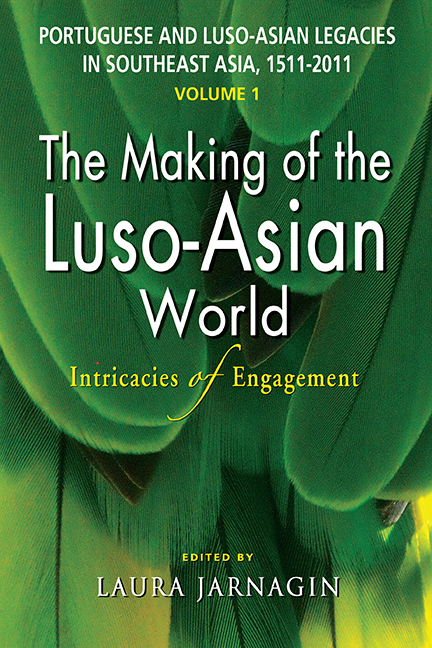 Portuguese and Luso-Asian Legacies in Southeast Asia, 1511–2011, vol. 1
Portuguese and Luso-Asian Legacies in Southeast Asia, 1511–2011, vol. 1 Book contents
- Frontmatter
- Contents
- List of Charts, Figures and Tables
- A Tribute to Glenn Ames
- Preface
- List of Contributors
- Glossary
- Introduction: Towards Clarity through Complexity
- Part One Adaptations and Transitions in the South and Southeast Asian Theatres, Sixteenth through Eighteenth Centuries
- 1 Supplying Simples for the Royal Hospital: An Indo-Portuguese Medicinal Garden in Goa (1520–1830)
- 2 Malacca in the Era of Viceroy Linhares (1629–35)
- 3 From Meliapor to Mylapore, 1662–1749: The Portuguese Presence in São Tomé between the Qutb Shāhī Conquest and Its Incorporation into British Madras
- 4 Eighteenth-Century Diplomatic Relations between Portuguese Macao and Ayutthaya: The 1721 Debt Repayment Embassy from Macao
- 5 Continuities in Bengal's Contact with the Portuguese and Its Legacy: A Community's Future Engangled with the Past
- Part Two Dispersion, Mobility and Demography from the Sixteenth into the Twenty-first Centuries
- Part Three Mixed Legacies: The Portuguese and Luso-Asians in the Twentieth and Twenty-first Centuries
- Bibliography
- Index
5 - Continuities in Bengal's Contact with the Portuguese and Its Legacy: A Community's Future Engangled with the Past
from Part One - Adaptations and Transitions in the South and Southeast Asian Theatres, Sixteenth through Eighteenth Centuries
Published online by Cambridge University Press: 21 October 2015
- Frontmatter
- Contents
- List of Charts, Figures and Tables
- A Tribute to Glenn Ames
- Preface
- List of Contributors
- Glossary
- Introduction: Towards Clarity through Complexity
- Part One Adaptations and Transitions in the South and Southeast Asian Theatres, Sixteenth through Eighteenth Centuries
- 1 Supplying Simples for the Royal Hospital: An Indo-Portuguese Medicinal Garden in Goa (1520–1830)
- 2 Malacca in the Era of Viceroy Linhares (1629–35)
- 3 From Meliapor to Mylapore, 1662–1749: The Portuguese Presence in São Tomé between the Qutb Shāhī Conquest and Its Incorporation into British Madras
- 4 Eighteenth-Century Diplomatic Relations between Portuguese Macao and Ayutthaya: The 1721 Debt Repayment Embassy from Macao
- 5 Continuities in Bengal's Contact with the Portuguese and Its Legacy: A Community's Future Engangled with the Past
- Part Two Dispersion, Mobility and Demography from the Sixteenth into the Twenty-first Centuries
- Part Three Mixed Legacies: The Portuguese and Luso-Asians in the Twentieth and Twenty-first Centuries
- Bibliography
- Index
Summary
Cross-cultural interactions were a significant feature of the sixteenth-century phase of Portuguese expansion. Sanjay Subrahmanyam, who has extensively examined this theme, suggests viewing this phenomenon as “a part of the history of the Portuguese presence in maritime Asia at a time when Portugal was itself under Habsburg rule”, that is, the late sixteenth and early seventeenth centuries. One may recall the individual prototypes who exemplified such cross-cultural interactions, namely, Felipe de Brito e Nicote, governor of Syriam in the early seventeenth century, and Gabriel Quiroga de San Antonio in Cambodia at the end of the sixteenth century. This chapter will argue that, if cross-cultural interactions in Portuguese settlements were characteristic of this expansive phase, the inversion of it, implying inward-looking tendencies, was its trait in the phase of imperial decline and contraction.
I contend that cross-cultural interactions were vibrant and vigorous so long as the Portuguese remained a dynamic power in colonization, maritime commerce, and political and diplomatic affairs. Once maritime links weakened or snapped, and the Portuguese developed an inclination to become more territorially based, interactions within cultures, rather than ones across cultures, found more intensity. Cross-cultural interactions abated or waned, and a process of narrowing down the ambit of the foreign culture set in, as the Portuguese identity absorbed local or native traits unto itself. Territorial or maritime extensions of Portuguese Asia were dependent on strategic and political factors, and the diversities that it could include were variables set by the degree of hegemony it could assert. Once that hegemony fell apart, the same niches of Portuguese existence could no longer be described as parts of “Portuguese Asia”, but rather as “Portuguese-speaking spaces”.
Subrahmanyam's argument, intended for a completely different purpose, has been taken here in its broadest implication to demonstrate processes within the shrinking spaces of Portuguese Asia. Subrahmanyam argues that there was a process in operation as of the sixteenth century that produced a “trans-cultural” synthesis. However, such a synthesis could only be possible while “Portuguese Asia” was expanding, not while it was struggling to survive and conceding physical space to its rivals. By the eighteenth century, the empire was militarily weakened and the white Eurasian population had failed to “reproduce itself in adequate numbers” all over Portuguese Asia. Thus a weakening of linkages and the collapse of the imperial structure produced Indo-Portuguese culture(s) within local settings.
- Type
- Chapter
- Information
- Portuguese and Luso-Asian Legacies in Southeast Asia, 1511–2011, vol. 1The Making of the Luso-Asian World: Intricacies of Engagement, pp. 106 - 128Publisher: ISEAS–Yusof Ishak InstitutePrint publication year: 2011


